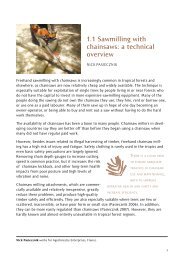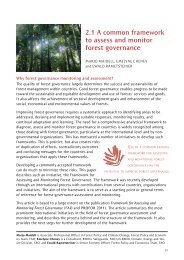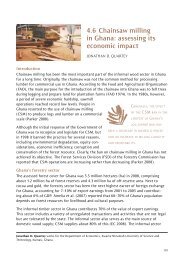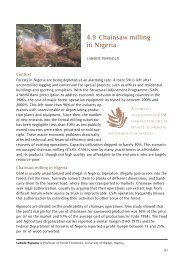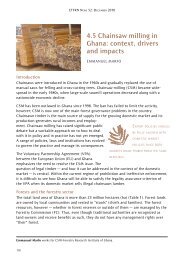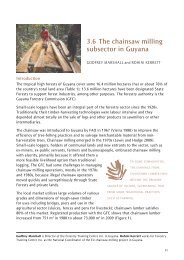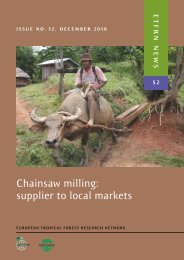Chainsaw milling: supplier to local markets - European Tropical ...
Chainsaw milling: supplier to local markets - European Tropical ...
Chainsaw milling: supplier to local markets - European Tropical ...
You also want an ePaper? Increase the reach of your titles
YUMPU automatically turns print PDFs into web optimized ePapers that Google loves.
194<br />
ETFRN NEws 52: DEcEmbER 2010<br />
4.11 chainsaw <strong>milling</strong><br />
in uganda<br />
ROBERT K. KAMBUGU, ABWOLI Y. BANANA and<br />
GEOFFREY ODOKONYERO<br />
status of forests in uganda 1<br />
Forests in uganda cover an area of about 4.9 million hectares (24% of the country’s <strong>to</strong>tal<br />
land area) making them an important element of land use (mwlE 2002). They are<br />
categorized as tropical high forests, woodlands and plantations. Their ownership falls in<strong>to</strong><br />
two broad categories: government reserves and private or community forests; 30% of the<br />
forests are in protected areas and 70% are on private land (Table 1).<br />
Government reserves constitute the permanent Forest Estate (pFE), which is set aside<br />
permanently for forestry activities and held in trust by the government (mwlE 2002).<br />
The national Forestry authority (nFa) manages the bulk (60.9%) of these forest reserves.<br />
District Forestry services (DFs) manages the<br />
<strong>local</strong> forest reserves (0.3%) while the uganda<br />
csm can help increase<br />
wildlife authority manages national parks<br />
(38.8%) (Turyahabwe and banana 2008).<br />
Timber producTion ouTside<br />
convenTional foresTs,<br />
no production is allowed in strict nature<br />
which can reduce The<br />
reserves, which comprise 20% of the forest<br />
pressure on These foresTs.<br />
reserves, but non-timber utilization activities are<br />
allowed in buffer zones, which comprise 30%. The remaining 50% are production zones<br />
set aside for the production of hardwood timber (odokonyero 2005a).<br />
<strong>Tropical</strong> high forests and plantations produce more than 80% of the country’s timber;<br />
plantations supply about 20% (mwlE 2002; nFa 2005). most of the plantations have<br />
been harvested and are almost exhausted. The supply of timber from natural forests is<br />
declining as well and forest cover continues <strong>to</strong> disappear at an alarming rate (Figure 1).<br />
uganda was projected <strong>to</strong> face a timber deficit by 2010 (odokonyero 2005a).<br />
robert K. Kambugu and Abwoli Y. banana work for the Department of Forest products Engineering, makerere<br />
university, and Geoffrey odokonyero works for the national Forestry authority, uganda.



